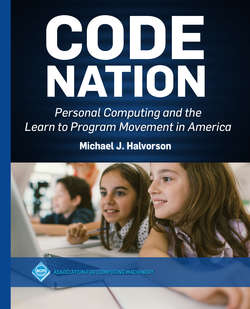Читать книгу Code Nation - Michael J. Halvorson - Страница 15
На сайте Литреса книга снята с продажи.
1.6Programmingmanifestos of movementManifestos of the Movement
ОглавлениеDespite my positive interactions with new programmers, I gradually learned that I was only a small part of the third or fourth wave of technical writers who had spread the message about computational literacy and learning to code in the years since the introduction of the first computers. Preparation of Programs for an Electronic Digital Computer was published in 1951 by Wilkes, Maurice Maurice Wilkes, David Wheeler, and Stanley Gill to instruct readers on how to formulate machine code for the revolutionary EDSAC computer at the University of Cambridge.14 Grace Mitchell, Daniel McCracken, and Elliott Organick also wrote creative programming primers Programming primersfor FORTRAN for Formula translation (FORTRAN) FORTRAN in the late 1950s and early 1960s, introducing non-specialists to programming.
Figure 1.6An exhibitor badge from the COMDEX/Fall ’90 trade show in Las Vegas, Nevada. (Photo courtesy of Michael Halvorson)
In the era of time-sharing systems and early PCs, a new wave of programming advocates supported the movement. These were pioneers like Albrecht, Robert Robert Albrecht and Finkel, LeRoy LeRoy Finkel, who participated in the People’s Computer Company and the Homebrew Computer Club in Menlo Park, California. From the beginning, these visionaries understood that not only did people need to buy computers and start programming, but they needed to learn how to program through books, materials, and social interaction. These computing innovators wrote fascinating programs and produced several best-selling computer titles, but they have largely been neglected in the history of computing. A new book by Joy Lisi Rankin, A People’s History of Computing in the United States, is an important exception to this lacuna, and Rankin demonstrates how Albrecht and his contemporaries inspired thousands of programmers to appreciate the benefits of BASIC.15
Also important in the 1960s and 1970s were the pioneering efforts of the educational theorists Luehrmann, Arthur Arthur Luehrmann, Papert, Seymour Seymour Papert, Cynthia Solomon, and Feurzeig, Wally Wally Feurzeig, all active in the computing hotbeds of Cambridge, Massachusetts and Greater Boston. Luehrmann coined the term Computer literacy “computer literacy” and encouraged students to learn structured programming with BASIC and Pascal Pascal. Papert, Solomon, and Feurzeig co-developed the Logoprogramming system Logo programming system at the MIT.Massachusetts Institute of Technology (MIT) Massachusetts Institute of Technology (MIT) Massachusetts Institute of Technology (MIT), and they wrote about its potential to teach computational thinking to children. Also, from the era of time-sharing systems, Ahl, David H. David Ahl, an early DEC employee, published tutorials that advocated for the use of computer games to teach programming concepts. My favorite of Ahl’s titles is 101 BASIC Computer Games, published by DEC in 1973. This book is filled with mimeographed program listings that Ahl received in the mail from BASIC users across the U.S. It was one of the first bestselling computer programming titles, selling tens of thousands of copies to novice computer users, hobbyists, academics, and working professionals.
Many of the earliest manifestos of the learn-to-program movement were sold out of VW vans and dusty boxes in computer clubs. However, this DIY world was also on the fringes of the professional software development community, which took its energy from debates within the nascent software Engineering movement engineering movement and the emerging discipline of computer science. The standard-bearers in this field created the computers, operating systems, and programming languages that would fuel the academic and commercial worlds of software development in the years to come. Readers learned about their important discoveries through conferences and influential computer books such as Knuth, Donald Donald Knuth, The Art of Computer Programming (1968 and later); Kathleen Jensen and Wirth, Niklaus Niklaus Wirth, The Pascal User Manual and Report (1971); Kernighan, Brian W. Brian Kernighan and Ritchie, Dennis Dennis Ritchie, The C Programming Language (1978); and Zaks, Rodnay Rodnay Zaks, Programming the Z80 (1979). Although these authors did not always publish programming primers, they helped experienced programmers understand the cadence of computer languages, taught people to devise data structures and Algorithms algorithms, and explored the advanced features of operating systems and computer architecture. The introduction of professional Professionaland commercial programming practices and commercial programming practices is a crucial stage of the learn-to-program movement.
